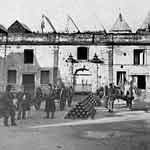
The Territorial Period (1821-1845)These early years as part of the United States were years of conflict for Florida. For years Indian groups who had been pushed off their land in Georgia and Alabama by white settlers had found refuge in Spanish Florida. These Indians, primarily Creeks, along with escaped African slaves, became known as Cimmarones or wild ones, the probable origin of the word Seminole. However, once Florida became a territory of the United States, these Indians were no longer safe. The US Army raided their settlements, and the Seminoles and whites engaged in a series of long, expensive wars ending with 4000 -5000 Seminoles being shipped to reservations in Oklahoma, and the tattered remnants of a proud people finally finding some refuge in the wilds of the Everglades. 
Samuel A. Cooley The Civil War Years (1861-1865)Florida was granted statehood in 1845 as the 27th state. At the beginning of the Civil War Florida was the third state to vote for Secession which she did on January 10, 1861. Confederate troops immediately took Fort Marion (Castillo de San Marcos) from the lone Union sergeant caretaker who asked for a receipt and travel money out of town. Believing the war would soon be over and would never come this far south, the Confederates removed most of the cannon from FortMarion and sent them to more strategic forts. 
The Flagler EraDuring the late 19th century, St. Augustine became the destination of America's rich and famous. In 1885, railroad tycoon and former Standard Oil partner Henry Morrison Flagler moved Florida's resorts to a new level with his 540-room grand Ponce de León Hotel in St. Augustine. The first of three Flagler hotels in the city, the Ponce de León (now the main building of Flagler College) combined exotic Spanish Renaissance and Moorish architectural features with innovative poured concrete construction. 
Declared a National MonumentDuring the fall of 1924, President Calvin Coolidge declared Castillo de San Marcos (then known as Fort Marion) under the authority of the 1906 Antiquities Act, to be a national monument. Forts Matanzas, Pulaski, Wood, and Castle Pinckney were included in the same signing. Later on, President Franklin D. Roosevelt sought a variety of ways to stimulated the American economy during his first term in office. Among his many ideas was the decision to streamline the responsibilities of the National Park Service (NPS). Fort Marion and many other national monuments were transferred to the NPS on August 10, 1933. In 1942 Congress restored the name Castillo de San Marcos to commemorate the fort's Spanish heritage. Read More. . . |
Last updated: April 18, 2023
